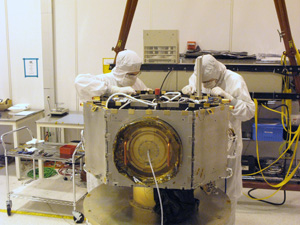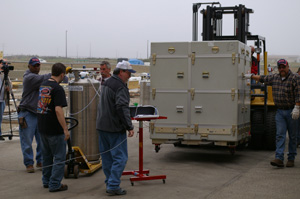Meet the IBEX Team: Mark Phillips

If Mark Phillips‘ family had not settled near an airport, he may never have decided to become an aerospace engineer.
When Mark was young, his family moved about five miles away from Houston‘s Intercontinental Airport. "I would race the airplanes on my bike, and I dreamed that I would either fly or build them," Mark said. "Since I was five, I wanted to be in the aerospace business."
While he was obsessed with airplanes and flying, the beauty of the night sky also awed him. "When I was a kid living in the city, I remember that in Houston you looked up and only saw a few stars," he said. "Fortunately, my family had some land in the country, far away from the city lights. From there, you could look up in the sky and see it riddled with stars that you never could see in the city. I was always amazed at the number of stars, and even galaxies, that could be seen in the night sky when not blinded by the city lights."
Throughout high school, Mark set his sights on attending the United States Air Force Academy to become a fighter pilot. "As I grew up, I enjoyed science and mathematics, and flying Air Force jets seemed like a natural fit," he said. "I got through high school with advanced math and physics classes, but then found out I was too tall to fit into the cockpit of a plane, dashing my dreams of flying fast planes."
Exceeding the height requirements for the Air Force was disappointing, but it did not keep Mark out of the aerospace business. He attended Texas A&M University, where he majored in aerospace engineering. "Many times along the way I struggled and wanted to quit [the aerospace engineering track]," Mark said of his college experience. "But, I was always surrounded with supportive people who encouraged me to 'aim higher than you ever expect to achieve.'" This encouragement of friends and family persuaded him to stick with aerospace engineering as his college major.

Image Credit: Orbital Sciences Corporation, IBEX Team
In college, Mark conducted undergraduate research, which eventually led him to pursue a master‘s degree in aerospace engineering. While there, he acquired skills he still uses today. "From an educational standpoint, what I learned in college is how to learn," Mark said. "I did learn a multitude of facts, figures and equations, but what I try to impress on young people I encounter is that college is learning how to learn. It is not memorizing equations. Don‘t get me wrong, I use equations all the time, but there are very few of them that I have memorized. That said, I can usually put my fingers on any of them within a few seconds because I have learned where they are located, and to trust my references more than my memory."
Today, Mark is glad he graduated with an aerospace engineering degree. He advises current engineering students to follow his example and "hang in there." Mark said, "The first couple of years of an aerospace engineering curriculum are the hardest. Just realize that not every student is dedicated to getting their degree and the faculty is looking for the people who really want that degree. Always follow your dreams — it‘s amazing how many people I‘m around who detest what they do for a living and hate going to work in the mornings. That's never been a problem for me. I love what I do!"
Mark is the deputy project manager for the IBEX Project, working out of the Southwest Research Institute in San Antonio, Texas. This means that he manages the various contractors hired to build and assemble different parts of the spacecraft, and oversees safety and the launch vehicle interfaces (how the IBEX spacecraft works with and attaches to the Pegasus rocket). Also, when the project manager takes a vacation, Mark "is saddled with the hard decisions".
He compares his work as deputy project manager to that of a firefighter. "I feel I&m constantly running from one fire to the next," Mark said. "When my firefighter neighbor got a promotion and gave me his old helmet, I decided to keep the helmet in my office as a reminder of the job... helping to find solutions to all the processes and problems that inevitably arise when putting together a mission as complicated as IBEX."
Most recently, Mark has been busy getting the IBEX spacecraft ready to transition to Vandenberg Air Force Base. "I've been finalizing all our launch site procedures so we can move [the spacecraft] to Vandenberg, and fuel and mount the flight system to the Pegasus rocket," Mark said.
Since the contractors Mark manages are located all over the world, he has logged thousands of miles in travel. This month, he traveled to California to meet with CSA Engineering, a Moog Company, who delivered the ShockRing that will cushion the IBEX spacecraft during its launch. Then, he flew to the East Coast to test the ShockRing at Orbital Sciences Corporation before returning to San Antonio. "Working with team members as close as California and as far away as Bern, Switzerland, including the launch site in Kwajelein, means I do a lot of traveling," Mark said. Since he began working on the IBEX project in 2006, Mark estimates that he has been on the road about 150 days, traveling a total of 300,000 miles.
Luckily, traveling is one of his favorite hobbies. Traveling, along with hunting and observing wildlife, are about Mark‘s only hobbies that do not involve water. "The activities my wife and I enjoy together seem to revolve around water," Mark said. "SCUBA diving, boating, wakeboarding, water skiing, tubing, lounging around by the boat, beach, or lake — we seem to be there if it has to do with water!"
While his hobbies are a great break from work, Mark genuinely loves what he does at the office, often working 10 or more hours a day. Although he enjoys all aspects of his job, his favorite part is the people he gets to work with. "The best part of my job is the interaction with the individuals who are working around me," he said, "I'm delighted to be surrounded by the extremely intelligent and hardworking people who have worked so hard to get IBEX to where we are today."
If the mission continues on schedule, in the fall Mark will be on Kwajalein Island to help launch the hundreds of thousands of hours of hard work known as IBEX safely into space. "I wish to thank the hundreds of people around the world who make up the IBEX team for letting me be a part of the mission," Mark said. "Go IBEX!"
